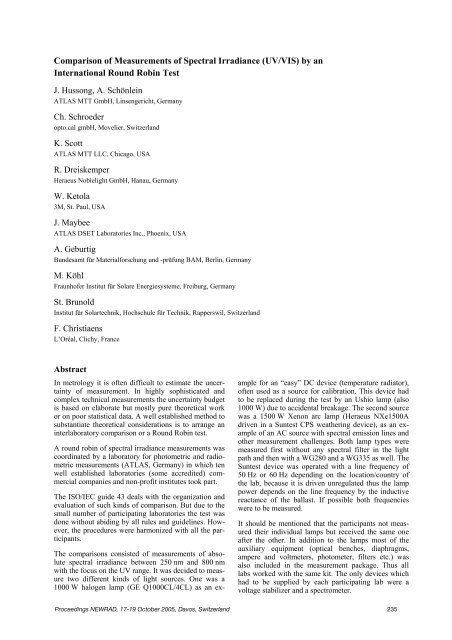Here - PMOD/WRC
Here - PMOD/WRC
Here - PMOD/WRC
Create successful ePaper yourself
Turn your PDF publications into a flip-book with our unique Google optimized e-Paper software.
Comparison of Measurements of Spectral Irradiance (UV/VIS) by an<br />
International Round Robin Test<br />
J. Hussong, A. Schönlein<br />
ATLAS MTT GmbH, Linsengericht, Germany<br />
Ch. Schroeder<br />
opto.cal gmbH, Movelier, Switzerland<br />
K. Scott<br />
ATLAS MTT LLC, Chicago, USA<br />
R. Dreiskemper<br />
Heraeus Noblelight GmbH, Hanau, Germany<br />
W. Ketola<br />
3M, St. Paul, USA<br />
J. Maybee<br />
ATLAS DSET Laboratories Inc., Phoenix, USA<br />
A. Geburtig<br />
Bundesamt für Materialforschung und -prüfung BAM, Berlin, Germany<br />
M. Köhl<br />
Fraunhofer Institut für Solare Energiesysteme, Freiburg, Germany<br />
St. Brunold<br />
Institut für Solartechnik, Hochschule für Technik, Rapperswil, Switzerland<br />
F. Christiaens<br />
L’Oréal, Clichy, France<br />
Abstract<br />
In metrology it is often difficult to estimate the uncertainty<br />
of measurement. In highly sophisticated and<br />
complex technical measurements the uncertainty budget<br />
is based on elaborate but mostly pure theoretical work<br />
or on poor statistical data. A well established method to<br />
substantiate theoretical considerations is to arrange an<br />
interlaboratory comparison or a Round Robin test.<br />
A round robin of spectral irradiance measurements was<br />
coordinated by a laboratory for photometric and radiometric<br />
measurements (ATLAS, Germany) in which ten<br />
well established laboratories (some accredited) commercial<br />
companies and non-profit institutes took part.<br />
The ISO/IEC guide 43 deals with the organization and<br />
evaluation of such kinds of comparison. But due to the<br />
small number of participating laboratories the test was<br />
done without abiding by all rules and guidelines. However,<br />
the procedures were harmonized with all the participants.<br />
The comparisons consisted of measurements of absolute<br />
spectral irradiance between 250 nm and 800 nm<br />
with the focus on the UV range. It was decided to measure<br />
two different kinds of light sources. One was a<br />
1000 W halogen lamp (GE Q1000CL/4CL) as an example<br />
for an “easy” DC device (temperature radiator),<br />
often used as a source for calibration. This device had<br />
to be replaced during the test by an Ushio lamp (also<br />
1000 W) due to accidental breakage. The second source<br />
was a 1500 W Xenon arc lamp (Heraeus NXe1500A<br />
driven in a Suntest CPS weathering device), as an example<br />
of an AC source with spectral emission lines and<br />
other measurement challenges. Both lamp types were<br />
measured first without any spectral filter in the light<br />
path and then with a WG280 and a WG335 as well. The<br />
Suntest device was operated with a line frequency of<br />
50 Hz or 60 Hz depending on the location/country of<br />
the lab, because it is driven unregulated thus the lamp<br />
power depends on the line frequency by the inductive<br />
reactance of the ballast. If possible both frequencies<br />
were to be measured.<br />
It should be mentioned that the participants not measured<br />
their individual lamps but received the same one<br />
after the other. In addition to the lamps most of the<br />
auxiliary equipment (optical benches, diaphragms,<br />
ampere and voltmeters, photometer, filters etc.) was<br />
also included in the measurement package. Thus all<br />
labs worked with the same kit. The only devices which<br />
had to be supplied by each participating lab were a<br />
voltage stabilizer and a spectrometer.<br />
Proceedings NEWRAD, 17-19 October 2005, Davos, Switzerland 235
















